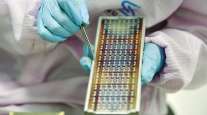Pioneer Leaps Into Driverless Vehicle Fray With Microscopic Mirrors

When it comes to helping driverless cars see, automakers have a choice between bulky top-mounted contraptions or cheaper but unproven laser-on-a-chip technology. Pioneer Corp. thinks it can deliver the best of both worlds.
The Japanese company has developed a new type of lidar — or laser radar — intended to drive its expansion into the burgeoning field of autonomous cars. At the Tokyo Motor Show this week, it’s showing off prototypes for the first time that use a swiveling, microscopic mirror to bounce pulses of light from surrounding objects. Because the device doesn’t employ the motor drive of its larger spinning cousins, it comes in a smaller package with a lower chance of mechanical failure.
Pioneer, a name once synonymous with cutting-edge electronics, plans to stake out a place in future car technology. It’s pushing into a lidar market projected to be worth $1.34 billion by 2024, but crowded with established players from Velodyne Lidar Inc. to LeddarTech Inc. Undeterred, Pioneer began shipping samples months ago and aims to sell its devices for under $100 when mass production begins as soon as 2020.
RELATED: GM buys lidar startup Strobe to accelerate self-driving cars
“Our advantage is that we have long experience in both the optical field as well as car navigation,’’ Satoshi Ohdate, the company’s senior executive officer in charge of consumer car electronics, said in an interview at the exhibition.
Self-driving cars can use cameras, radar and lidar to detect lanes, traffic, pedestrians, signs, stoplights and anything else in the vehicle’s path. But lidar is superior to radar when it comes to detecting smaller objects, and also outperforms cameras in low-light conditions and against glare. It’s a technology considered key to achieving true vehicle autonomy and is at the center of a lawsuit between Uber Technologies Inc. and Google’s Waymo unit. They also cost from a few thousand dollars to as much as $70,000.
RELATED: In break from Otto, Uber upgrades lidar to third-party, off-the-shelf system
Pioneer is developing several types of lidar to offer high resolution at long- and mid-range as well as wide-view scan for near objects. It hasn’t disclosed specifications, but says the technology can be used to enable level 3 autonomy, meaning a driver would only have to interfere in case of an emergency.
The Japanese company’s laser know-how dates back to the late 1970s and the defunct LaserDisc, a precursor to the DVD. The company now gets 80% of its revenue from automotive applications such as car audio and navigation and is looking to get into self-driving applications, heads-up displays and other cockpit sensors for growth.
But in lidar, it faces competition from so-called solid-state sensors that lack moving parts. Velodyne, which helped pioneer mechanical lidar, introduced a solid-state version of its technology this summer and has the backing of Ford Motor Co. Startups from Silicon Valley’s Quanergy Systems Inc. to Quebec City-based LeddarTech are also developing their own versions.
“The car makers haven’t yet settled on specific partners when it comes to lidar,’’ Ohdate said. “There is plenty of opportunity if you are offering something good at low cost.’’




